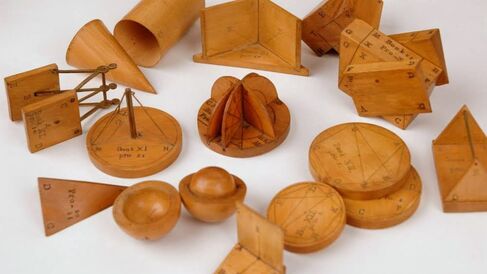Wooden Geometric Models Made by George Adams

These Geometric Models by George Adams were a teaching aid for people studying mathematics in the mid-18th century. Models had to compete with other 2-dimensional aids, such as diagrams in books, and did not remain popular for long.
Teaching geometry using models
During the 18th century the standard textbook for learning geometry was Euclid'sElements of Geometry. This work had been the standard text since Euclid first compiled it in the 3rd century B.C. The models made by Adams illustrate those parts of Euclid that deal with solid geometry (Books XI and XII).
The idea was simple: 3-dimensional models would help students to visualise the geometrical propositions more easily than 2-dimensional images in books. People could learn more readily by handling an object. This selling point of models was given at the time, with one 18th-century author claiming that
"it is almost as necessary as in mechanics, to exhibit the objects, whose qualities are to be taught; and to call in the joint assistance of the hands and eyes." (1)
Other teaching methods
However, these models were not the first time that Euclid's geometry had been represented in three dimensions. Since the very first English edition of Euclid in 1570, authors had experimented with methods of using books to demonstrate solid geometry. Some used flaps to fold out, others cut-out diagrams or different colours.
In the case of geometry though, none of these caught on and 2-dimensional diagrams have remained the norm. This suggests that geometric models did not offer enough advantages. This is in contrast to other subjects, such as anatomy, where models were widely used and model-making thrived during the 18th century.
Whilst models might not have caught on as a means for teaching geometry, the set made by Adams survives today as an elegant reminder of the different ways of representing Euclid.
References
- T. Beddoes, Observations on the Nature of Demonstrative Evidence... (London, 1793), p. 113.
Mike Rich
Mike Rich, 'Wooden geometric models made by George Adams', Explore Whipple Collections, Whipple Museum of the History of Science, University of Cambridge, 2006.
